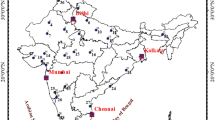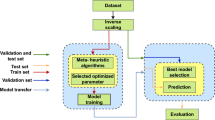Abstract
Interpolation methods are frequently used during gravity surveys to improve the coverage of gravity data, particularly in areas where data is scarce and sparse. This is a region which, due to its isolation, has only benefited from a single gravimetric survey campaign, with very little data collected, thus constituting a real obstacle to a geophysical study, even though it has real mining potential (Claude et al. in Adv Remote Sens 10:1, 2021). The ANN (Artificial Neural Network) method is a recent interpolation method applied to gravimetry that imitates the functioning of the biological neural network of the human brain. This paper aims to confirm the effectiveness of the ANN method on the densification of gravity data in the Lom-Pangar region where the distribution of gravity data is particularly weak and irregularly distributed. The Matlab program allowed us to build an ANN architecture with an input layer, a hidden layer, and an output layer. Statistical analysis and regression curves allow us to evaluate the degree of similarity between the Bouguer gravity data obtained in-situ and that calculated by the artificial neural network. In this study, good results were obtained using these statistical parameters: the correlation coefficient (R2 = 0.9811), the root mean square error (RMSE = 0.0804) and the mean bias error (MBE = 0.0003). Even better, these statistical parameters are significantly better compared to those obtained via other classical interpolation methods. The observed Bouguer gravity data and those obtained by the ANN method show relevant similarities, so we obtained a map of Bouguer that showed more pronounced anomalies, with more pronounced shapes and contours; reflecting specific and deeper geological structures compared to those obtained in this region using other methods. The ANN method is therefore appropriate for interpolating gravity data and could be useful in improving the gravity coverage of the Lom-Pangar region and other regions of Cameroon and indeed any region of the world that may experience similar difficulties.
Article highlights
-
Designing an artificial neural network adapted to a geophysical study;
-
Densify Bouguer gravity anomalies from geographic coordinates;
-
Very satisfactory statistical parameters obtained from the neural method, compared to other empirical interpolation methods;
-
Real geological features identifiable on the Bouguer anomaly map generated via the neural network method.











Similar content being viewed by others
Data Availability
The data used to support the fndings of this study are available from the corresponding author upon request.
References
Apollinaire B, Joseph K, Tabod TC, Loudi Y, Robert N, Ludovic KH et al (2017) Subsurface structural mapping using combined terrestrial and grace gravity data of the Adamawa plateau (North-Cameroon). Int J Geosci 8:869
à Nyam FME, Yomba AE, Nzeuga AR, Soh AS (2020) 2.5-D Earth crust density structure modeling of the central part of Cameroon using gravity data. Open J Earthq Res 9:289–306
Bofinger S, Heilscher G (2006) Solar electricity forecast-approaches and first results. In: 20th European Photovoltaic Solar Energy Conference
Bosch A, Miñán A, Vescina C, Degrossi J, Gatti B, Montanaro P et al (2008) Fourier transform infrared spectroscopy for rapid identification of nonfermenting gram-negative bacteria isolated from sputum samples from cystic fibrosis patients. J Clin Microbiol 46:2535–2546
Boukeke, D-B (1994) Structures crustales d'Afrique Centrale déduites des anomalies gravimétriques et magnétiques: le domaine précambrien de la République Centrafricaine et du Sud Cameroun," Paris 11
Claude NP, Patrick AS, Igor OAOU, Arsene M, Justine Y, Daniel NJ et al (2021) 2.5 D Crustal models derived from analytical polynomial separation technique and spectral analysis of gravity data with their probable gold mineralization migrations (Batouri, SE-Cameroon). Adv Remote Sens 10:1
Djomani YP, Albouy Y (1993) A gravity study of Cameroon, West Africa, and geodynamical implications. In: SEG Technical Program Expanded Abstracts 1993, ed: Society of Exploration Geophysicists, pp 460–462
Essi JMA, Marcel J, Atangana JQY, Ahmad AD, Dassou EF, Mbossi EF et al (2017) Interpretation of gravity data derived from the Earth Gravitational Model EGM2008 in the Center-North Cameroon: structural and mining implications. Arab J Geosci 10:130
Ganwa AA, Frisch W, Siebel W, Ekodeck GE, Shang CK, Ngako V (2008) Archean inheritances in the pyroxene–amphibole-bearing gneiss of the Méiganga area (Central North Cameroon): Geochemical and 207Pb/206Pb age imprints. CR Geosci 340:211–222
Heiskanen WA, Moritz H (1967) Physical geodesy(Book on physical geodesy covering potential theory, gravity fields, gravimetric and astrogeodetic methods, statistical analysis, etc)
Hornik K (1991) Approximation capabilities of multilayer feedforward networks. Neural Netw 4:251–257
Kamto PG, Lemotio W, Tokam A-PK, Yap L (2021) Combination of terrestrial and satellite gravity data for the characterization of the southwestern coastal region of cameroon: appraisal for hydrocarbon exploration. Int J Geophys, vol. 2021
Krauss G, Depecker P, Kindagen JI (1997) Méthode des réseaux de neurones pour le calcul des coefficients de vitesse. Application aux écoulements de l’air dans les bâtiments. Revue Générale De Thermique 36:180–191
Kwékam M, Affaton P, Bruguier O, Liégeois J-P, Hartmann G, Njonfang E (2013) The Pan-African Kekem gabbro-norite (West-Cameroon), U-Pb zircon age, geochemistry and Sr–Nd isotopes: Geodynamical implication for the evolution of the Central African fold belt. J Afr Earth Sc 84:70–88
Kwékam M, Liégeois J-P, Njonfang E, Affaton P, Hartmann G, Tchoua F (2010) Nature, origin and significance of the Fomopéa Pan-African high-K calc-alkaline plutonic complex in the Central African fold belt (Cameroon). J Afr Earth Sc 57:79–95
Marzoli A, Renne PR, Piccirillo EM, Francesca C, Bellieni G, Melfi AJ et al (1999) Silicic magmas from the continental Cameroon Volcanic Line (Oku, Bambouto and Ngaoundere): 40 Ar-39 Ar dates, petrology, Sr-Nd-O isotopes and their petrogenetic significance. Contrib Miner Petrol 135:133–150
Mouzong Pemi M, Kamguia J, Nguiya S, Manguelle-Dicoum E (2018) Depth and lineament maps derived from north Cameroon gravity data computed by artificial neural network. Int J Geophys, vol 2018
Ngalamo JFG, Bisso D, Abdelsalam MG, Atekwana EA, Katumwehe AB, Ekodeck GE (2017) Geophysical imaging of metacratonizaton in the northern edge of the Congo Craton in Cameroon. J Afr Earth Sc 129:94–107
Ngalamo JFG, Sobh M, Bisso D, Abdelsalam MG, Atekwana E, Ekodeck GE (2018) Lithospheric structure beneath the Central Africa Orogenic Belt in Cameroon from the analysis of satellite gravity and passive seismic data. Tectonophysics 745:326–337
Njonfang E, Ngako V, Moreau C, Affaton P, Diot H (2008) Restraining bends in high temperature shear zones: the “Central Cameroon Shear Zone”, Central Africa. J Afr Earth Sc 52:9–20
Nzenti J, Barbey P, Bertrand J, Macaudière J (1994) La chaîne panafricaine au Cameroun: cherchons suture et modèle. Abstracts 15eme RST, Nancy, Société Géologique France, édition Paris, vol. 99
Tadjou JM, Nouayou R, Kamguia J, Kande HL, Manguelle-Dicoum E (2009) GRAVITY analysis of the boundary between the Congo Graton and the Pan-Africal belt of Cameroon. Austrian J Earth Sci, vol 102
Tanko Njiosseu EL, Nzenti JP, Njanko T, Kapajika B, Nédélec A (2005) "Reply to'Comment on New U sbnd Pb zircon ages from Tonga (Cameroon): coexisting Eburnean-Transamazonian (2.1 Ga) and Panafrican (0.6 Ga) imprints' by Sadrack Félix Toteu and Joseph Penaye," Comptes Rendus Geosci 337:1553–1554
Toteu S, Van Schmus W, Penaye J, Michard A (2001) New U-Pb and Sm–Nd data from north-central Cameroon and its bearing on the pre-Pan African history of central Africa. Precambr Res 108:45–73
Toteu S, Van Schmus W, Penaye J, Nyobe J (1994) U·Pb and Sm·N edvidence for Eburnian and Pan-African high-grade metamorphism in cratonic rocks of southern Cameroon. Precambr Res 67:321–347
Vicat J, Bilong P (1998) Esquisse géologique du Cameroun. Géosciences Au Cameroun 1:3–11
Acknowledgements
The authors are indebted to the IRD (Institut de Recherche pour le Développement) for providing the data used in this work. Most of the figures in this paper were produced using Geosof software developed by Ian Maclead and Tim Dobush for Exploration Geophysics and MatLab (Mathematics Laboratory). We also thank the anonymous referees for their helpful suggestions and comments.
Author information
Authors and Affiliations
Corresponding author
Ethics declarations
Conflict of Interest
The authors reveal that there are no conficts of interest regarding the publication of this paper.
Additional information
Publisher's Note
Springer Nature remains neutral with regard to jurisdictional claims in published maps and institutional affiliations.
Supplementary Information
Below is the link to the electronic supplementary material.
Rights and permissions
About this article
Cite this article
Diffo, S., Lemotio, W., Mezoue Adiang, C. et al. Contribution of the artificial neural network (ANN) method to the interpolation of the Bouguer gravity anomalies in the region of Lom-Pangar (East-Cameroon). Geomech. Geophys. Geo-energ. Geo-resour. 8, 32 (2022). https://doi.org/10.1007/s40948-022-00341-1
Received:
Accepted:
Published:
DOI: https://doi.org/10.1007/s40948-022-00341-1




